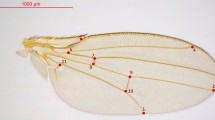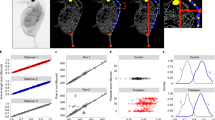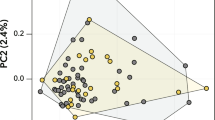Abstract
We examined the relationship between developmental stress and fluctuating asymmetry in a natural population of Drosophila pachea, a cactophilic fruitfly. Cactus host variation was found to exert significant influence on the size of legs and of wings of emerging adults, but stressors associated with reduced size did not show the predicted increase in fluctuating asymmetry for either leg or wing length. These findings underscore questions raised by other investigators as to the broad utility of fluctuating asymmetry as a measure of environmental stress
Similar content being viewed by others
References
Breitmeyer, C.M. (1994) Host plant availability and population size in Sonoran Desert Drosophila. Master's thesis, Arizona State University.
Clarke, G.M. (1993) Patterns of developmental stability in Chrysopa perla L. (Neuroptera: Chrysopidae) in response to environmental pollution. Environ. Entomol. 22, 1362–6.
Clarke, G.M. (1994) Developmental stability analysis: an early-warming system for biological monitoring of water quality. Australian Biologist 7, 94–104.
Coyne, J.A. (1985) Genetic studies of three sibling species of Drosophila with relationship to theories of speciation. Genetical Research 46, 169–92.
Etges, W.J. and Heed, W.B. (1987) Sensitivity to larval density in populations of Drosophila mojavensis: influences of host plant variation on components of fitness. Oecologia 71, 375–81.
Fogleman, J.C. (1982) The role of volatiles in the ecology of cactophilic Drosophila. In Ecological Genetics and Evolution: The cactus-yeast-Drosophila model system (J.S.F. Barker and W.T. Starmer, eds) Sydney: Academic Press.
Graham, J.H., Roe, K.E. and West, T.B. (1993) Effects of lead and benzene on the developmental stability of Drosophila melanogaster. Ecotoxicology 2, 185–95.
Graham, J.H., Freeman, D.C. and Emlen, J.M. (1993) Developmental instability: a sensitive indicator of populations under stress. In Environmental Toxicology and Risk Assessment Am. Soc. Testing and Material, Philadelphia (W.G. Landis, J.S. Hughes and M.A. Lewis, eds) pp. 136–58.
Heed, W.B. and Mangan, R.L. (1986) Community ecology of Sonoran Desert Drosophila. In The Genetics and Biology of Drosophila, vol 3e (M. Ashburner, H.L. Carson, and J.N. Thompson, eds) pp. 311–45. Academic Press, London.
Kircher, H.W., Heed, W.B., Russell, J.S. and Grove, J. (1967) Senita cactus alkaloids: Their significance to Sonoran desert Drosophila ecology. J. Insect Physiol. 13, 1869–74.
Kircher, (1982) Chemical composition of cacti and its relationship to the Sonoran Desert Drosophila. In Ecological Genetics and Evolution: The cactus-yeast-Drosophila model system (J.S.F. Barker and W.T. Starmer, eds).
Markow, T.A. (ed.) (1994) Developmental Instability: Its Origins and Evolutionary Implications. Dordrecht: Kluwer.
Markow, T.A. and Ricker, J.P. (1992) Male size, developmental stability, and mating success in natural populations of three Drosophila species. Heredity 69, 122–7.
Palmer, A.R. (1994) Fluctuating asymmetry analyses: a primer. In Developmental Instability: Its Origins and Evolutionary Implications (T.A. Markow, ed.) pp. 355–64. Kluwer, Dordrecht.
Parsons, P.A. (1961) Fly size, emergence time, and sternopleural chetae number in Drosophila melanogaster. Heredity 16, 455–73.
Parsons, P.A. (1990) Fluctuating Asymmetry: an epigenetic measure of stress. Biological Reviews 63, 131–45.
Pitnick, S. (1993) Operational sex ratios and sperm limitation in populations of Drosophila pachea. Behav. Ecol. Sociobiol. 33, 383–91.
Rockwood-Sluss, E.S., Johnston, J.S. and Heed, W.B. (1973) Allozyme genotype-environment relationships. I. Variation in natural populations of Drosophila pachea. Genetics 73, 135–46.
Thomas, R.H. (1993) Ecology of body size in Drosophila buzzatii: untangling the effects of temperature and nutrition. Ecol. Entomol. 18, 84–90.
Ward, B.L., Starmer, W.T., Russell, J.S. and Heed, W.B. (1974) The correlation of climate and host plant morphology with a geographic gradient of an inversion polymorphism in Drosophila pachea. Evolution 28, 565–75.
Wardhaugh, K.G., McMahon, R.J., Axelsen, A., Rowland, M.W. and Wanjura, W. (1994) Effects of ivermectin residues in sheep dung on the development and survival of the bushfly, Musca vetustissima Walker, and a scarabine dung beetle, Euonticellus fulvus goese. Vet. Parasitol. 48, 139–57.
Author information
Authors and Affiliations
Rights and permissions
About this article
Cite this article
Hurtado, L., Castrezana, S., Mateos, M. et al. Developmental stability and environmental stress in natural populations of Drosophila pachea. Ecotoxicology 6, 233–238 (1997). https://doi.org/10.1023/A:1018678827931
Issue Date:
DOI: https://doi.org/10.1023/A:1018678827931




